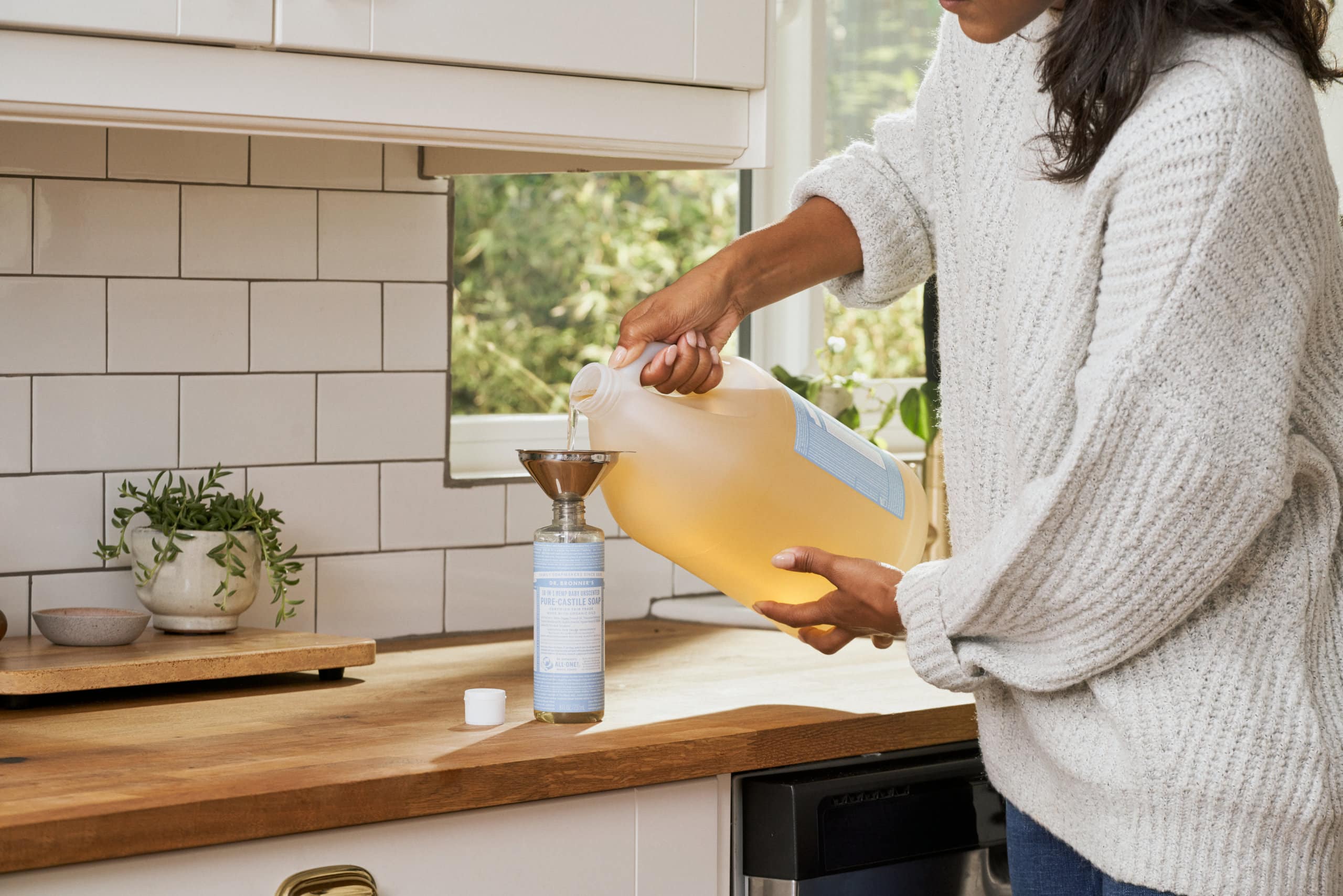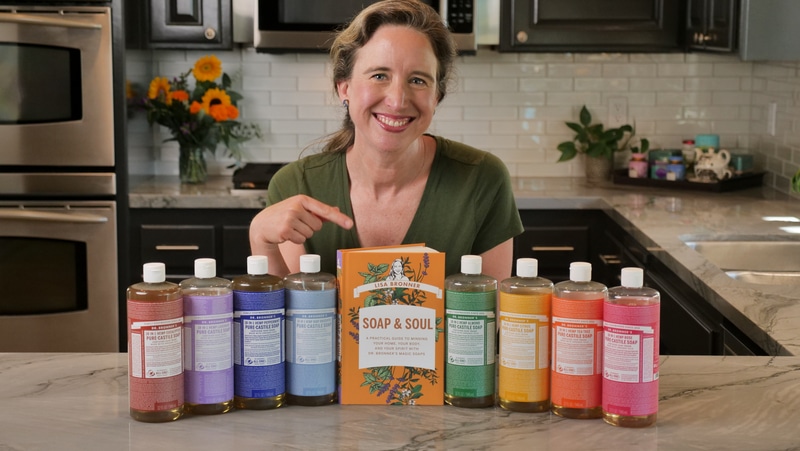3 Mind-Blowing Soap Hacks from Lisa Bronner’s “Soap & Soul”
Lisa Bronner’s Soap & Soul offers a wealth of insights and practical tips for home and body care. This guide to green living centers on harnessing the versatility of Dr. Bronner’s products while adopting a low-tox lifestyle. Below, we explore three mind-blowing soap hacks from Lisa Bronner’s book that are guaranteed to transform your skincare routine and enhance your self-care practices!
Hack 1: How to Master Castile Soap Dilutions
Because Dr. Bronner’s Pure-Castile Soap is concentrated, it can be diluted for numerous uses. In Soap & Soul, Lisa provides a wealth of dilutions, whether you’re using it as a facial cleanser, body wash, or household cleaner.
From Soap & Soul: Foaming Hand Soap
This is one of the two dilutions using castile soap you should go make right now. The Pure-Castile soap does not work well in a standard pump, but it works gorgeously in a foaming pump. Foaming pumps have a small chamber that forces air into the liquid solution. It’s a great way to keep kids (or absent-minded adults) from using too much soap. And foam is fun.
I use all sorts of foaming pump dispensers —one at every sink from the bathroom to the kitchen. Mason jars with special tops, plastic bottles with suction cup bottoms, and an electric touchless, rechargeable dispenser by my kitchen sink.
I use the foam for washing my hands, my face, my nightguard, my makeup brushes, and in the kitchen for washing a piece of fruit, a single dish, or on a washcloth to wash a counter.
- 1 part Pure-Castile Soap
- 3 parts Water
How To:
- In your foaming pump, combine the soap and water. If you have a 1 cup pump, this would be ¼ cup Castile Soap and ¾ cup water. Distilled, reverse-osmosis, or softened water will make a clearer solution, but any water is fine. Cloudiness in the solution is a sign of water hardness and is harmless. It will settle at the bottom of the jar. It is not the soap and does not need to be mixed back in.
- Swirl to mix.
For a quick reference, view the Castile Soap Dilutions Cheat Sheet.
Hack 2: How to Make Your Own Castile Soap Scent with Essential Oils

Essential oils are nature’s aromatic powerhouses, renowned for their therapeutic properties. In Soap & Soul, Lisa encourages the addition of essential oils to soap for both their fragrance and skincare benefits. Lavender oil, for example, soothes and calms the skin, making it ideal for sensitive or irritated skin types. Tea tree oil boasts antibacterial and antifungal properties, making it a valuable addition to acne-fighting formulations. By incorporating essential oils into your soap, you not only personalize the scent but also enhance its skincare properties.
From Soap & Soul: How do I add essential oils to the Pure-Castile Soaps?
This is a great way to customize a scent. You can start with the Baby Unscented to make a scent that is completely your own or modify one of the other scents with an addition of your choice. You can scent either a whole undiluted bottle of soap or one of the many dilutions. Start by adding just a few drops and swirl. Essential oils go a long way, and different essential oils have different strengths. Where you might use 20 drops of one, you might get your desired scent level with 5 drops of another. So start with fewer drops and increase based on your preference. Swirl thoroughly after each addition. If the soap sits for several days, you may find you need to swirl in the essential oils again. When purchasing essential oils, look for organic pure essential oil. If it doesn’t say “pure essential,” then it is diluted in some other carrier oil, like olive oil. Mixing two Pure-Castile Soap scents is another way to create a custom scent.
For a quick reference, check out How to Make Your Own Castile Soap Scent
Hack 3: How to Simplify Your Body Care Routine and Avoid Common Toxins in Commercial Products

Encountering chemicals and toxins in personal care products is seemingly unavoidable. In Soap & Soul, Lisa details what toxins to avoid in common commercial products and what to use in its place. Here, Lisa shows a chemical-free method for removing makeup.
From Soap & Soul: Removing Makeup
Dr. Bronner’s Pure-Castile Soap lifts sunscreen and even the heaviest concealer and foundation. Washing with it at the end of the day makes my skin feel brand new.
However, for makeup close to the eyes, especially waterproof eyeliner and mascara, dissolve it with pure Dr. Bronner’s Virgin Coconut Oil instead. No fancy multi-ingredient makeup remover—just one simple oil. Coconut oil works because many mascaras and eye liners, especially if they’re waterproof, are oil- or wax-based. Oil dissolves oil. Also, coconut oil does not have a pH and so will not irritate the eyes.
I use this after I’ve washed my face, and I leave the residual coconut oil as a moisturizer. However, you could do this before you wash the rest of your face to wash off the residual coconut oil.
How To:
- With the tip of the ring finger, gently massage coconut oil into the liner and mascara.
- Wipe away with a washable/reusable cotton pad, a soft tissue, or a cotton ball.
Cleaning Makeup Brushes
Makeup brushes must be cleaned regularly to remove the buildup of makeup, oils, and bacteria. If it’s been a while since you cleaned yours, the first time may startle you and convince you to clean them more often.
How To:
- Wet the makeup brush well.
- Apply a drop or two of the Castile Liquid Soap or one pump of foaming soap to the bristles. Alternately, run the brush across the Castile Bar Soap.
- Massage throughout the bristles. Add more soap for larger or more caked brushes.
- Fill a bowl with clean water and rinse the bristles. If the water gets too murky, empty it and refill.
- Gently blot the bristles with a clean towel and allow to air dry completely.
- Fluff the bristles once dry.
From mastering the art of dilution to exploring the endless possibilities of GIY (Green-It-Yourself) soap recipes, Soap & Soul empowers readers to take control of their skincare journey with confidence and creativity.





Leave a comment